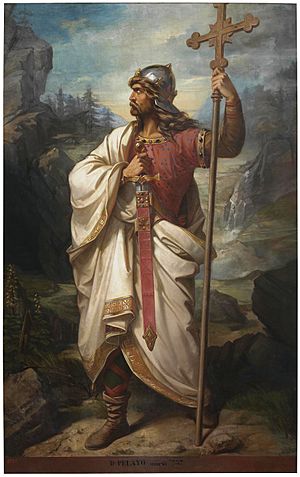Pelagius of Asturias facts for kids
Quick facts for kids Pelagius |
|
|---|---|

A depiction of the Battle of Covadonga in a decorated initial from a 12th-century illustrated manuscript of the Liber testamentorum. Pelayo, crowned and holding a cross, is leading at the top.
|
|
| King of Asturias | |
| Reign | 718–737 |
| Successor | Favila of Asturias |
| Born | c. 685 |
| Died | 737 |
| Burial | Santa Cueva de Covadonga |
| Issue | |
| Dynasty | Astur-Leonese dynasty |
| Father | Favila of Cantabria |
| Religion | Chalcedonian Christianity |
Pelagius (born around 685 – died 737) was a Visigoth nobleman. He is famous for starting the Kingdom of Asturias in 718. Pelagius is often seen as the person who began the Reconquista. This was a long period when Christian kingdoms slowly took back control of the Iberian Peninsula from the Moors (Muslim rulers). He also founded the Asturian royal family. This family became the ancestors of many future kings and queens in Spain and Portugal.
Early Life and Challenges
Pelagius was a nobleman from the Visigoth people. His father was named Fafila. Some old writings say that Fafila was a duke, a type of leader, in a region called Gallaecia. He was killed by a king named Wittiza.
Other stories say Pelagius was the grandson of another king, Chindasuinth. They also say King Wittiza had Pelagius's father blinded. Wittiza then sent Pelagius away from Toledo when he became king in 702. Most old stories agree that Pelagius was a Visigoth nobleman who was exiled by Wittiza.
Later stories tell us about a Berber governor named Munuza. He was in charge of a place called Iegione (either Gijón or León). Munuza wanted to capture Pelagius. He sent word to Tariq ibn Ziyad, a famous Muslim general. Tariq ordered Munuza to send Pelagius to Córdoba. This suggests that the Arab rulers had already taken control of the Asturias region.
Pelagius Becomes King
At some point, Pelagius decided to fight back against the new rulers. We don't know exactly why he rebelled. However, it was common for local leaders in Visigothic Spain to challenge their superiors.
A Muslim army was sent to stop him. It was led by Alkama and a Christian bishop named Oppa. A big battle happened near Covadonga. In this battle, Alkama was killed, and Oppa was captured. Muslim records from that time described Pelagius and his small group as "thirty wild donkeys." This shows how small his force was compared to the Muslim army.
The battle is usually thought to have happened around 718 or 719. Some historians believe it was as late as 722.
After this victory, local leaders chose Pelagius as their princeps. This means he became their main leader or prince. He set up his capital city in Cangas de Onís. An old text says:
And he [Pelagius], going to his mountainous lands, gathered all those who were going to council and ascended a big mountain named Asseuua. He spread his orders between all the Astures, who gathered in council and elected Pelagius as their princeps.
His new kingdom started small, mainly in eastern Asturias. But it quickly grew bigger. Pelagius arranged for his daughter, Ermesinda, to marry Alfonso I. Alfonso was the son of Duke Peter of Cantabria, a powerful neighbor. This marriage helped to make Pelagius's kingdom stronger.
Pelagius ruled for about 18 or 19 years. He died in 737. His son, Fafila, became the next ruler.
Pelagius was first buried in the church of Santa Eulalia de Abamia. This church is near Cangas de Onís. Later, King Alfonso X of Castile moved his remains to the Holy Cave of Covadonga. His wife, Gaudiosa, and his sister were also buried there. Besides his son Fafila, Pelagius had a daughter, Ermesinda. She and King Alfonso I became the ancestors of all the later kings and queens of Asturias.
How We Know About Pelagius

Most of what we know about Pelagius comes from two old Latin books. These books were written in the late 800s in the kingdom he founded. One is called the Chronica Albeldensia. The other is the Chronicle of Alfonso III. These old writings help us understand the life and actions of Pelagius.
See also
 In Spanish: Don Pelayo para niños
In Spanish: Don Pelayo para niños


